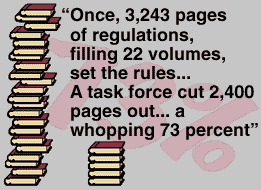Archive
Punching the Clock-- NOT: Department of Labor
Grabbing lunch in the employees' dining room shortly after taking office, Labor Secretary Robert Reich struck up a conversation while waiting in line to pay.
"What do you do?" Reich asked a woman.
"I'm a clerk-typist," she replied. "What do you do?"
"I'm the secretary," he said.
"To whom?" she asked.
You could hardly blame the woman for her confusion. She probably had never seen the department's secretary in that room before.
In the old days--that is, the days before Reich took charge--the department's executive staff could eat in the executive dining room, on the second floor of its Constitution Avenue building. But Reich closed the dining room soon after arriving.[10]
The department's employees have begun to transform the institution.[11] Once, 3,243 pages of regulations, filling 22 volumes, set the rules for virtually everything imaginable. A task force cut 2,400 pages out of them--a whopping 73 percent. (Reich says he'd like to reduce the regulations to just one card.) No more special forms for traveling employees to get reimbursed for phone calls. No more reviews by department headquarters of every personnel award. No more written reports on conferences attended by more than nine employees. And, unless you take leave or work overtime, no more time cards. That step alone eliminates 14,000 documents that used to fly around the system every two weeks.
At Labor's Pension and Welfare Benefits Administration, field workers now spend more time doing their jobs--and less writing meaningless reports that, for the most part, serve no useful purpose. Rather than write quarterly reports on each of their investigations-- reports that totaled nearly 5,000 each quarter--they report on only their top 20 investigations. Also at Pension and Welfare Benefits, workers now can discuss their investigations of company pension funds with the company, thus enabling them to clear up misunderstandings before submitting their reports.

The department's transformation, however, is not just geared to helping its employees. The changes are beginning to help its customers--the worker who needs safety and health protection, the laid-off worker who seeks retraining to switch occupations, and so on.
To learn what it's doing right and wrong, the department has been surveying various sets of customers. The Employment and Training Administration, which surveyed laid-off workers, discovered that 43 percent did not find its services either extremely or very helpful; Reich set a goal of cutting that figure by 10 percent this fall.
Similarly, the Bureau of Labor Statistics surveyed 30,000 users of its data on the consumer price index and found that they needed the information quicker than they were receiving it. They had to wait three weeks for summary data and six weeks for the details. Since the bureau's customer focus team streamlined the process, the bureau is sending its summary nine days sooner and the details 16 days sooner.
In From Red Tape to Results , NPR proposed the creation of competitive, one-stop career development centers for all Americans. "Nowhere on the government reinvention front is action more urgently needed," the report said, "or are potential rewards greater." [12] The Administration's Reemployment Act of 1994, submitted to Congress in March, does just this. The bill sets the framework for a nationwide system of one-stop career centers serving all Americans. In these centers, job seekers can get all the information they need on job opportunities, skill requirements, and training providers, and they can determine their eligibility for federal employment and training programs.
Program consolidation is another way of cutting through red tape. The General Accounting Office has identified over 154 federal employment and training programs, through which 14 departments and agencies spend $25 billion a year.[13] To create an employment and training system from all these programs, the Administration has to coordinate, consolidate, or eliminate programs with a variety of purposes, target populations, and services. The Administration's Reemployment Act took a first step toward program consolidation. It combines six Labor Department programs for dislocated workers into a single program that provides a comprehensive package of reemployment and training to all dislocated workers, regardless of the reason for their job loss.
On Capitol Hill, key lawmakers also expressed interest in consolidating employment and training programs. Senate Labor and Human Resources Committee Chairman Edward M. Kennedy, D-Massachusetts, and the panel's ranking Republican, Nancy L. Kassebaum, R-Kansas, are working on a joint measure to bring together many of these programs, including some in other committees" jurisdictions. [14]
Even before Congress began debating the Administration's and other proposals, Reich moved to consolidate his own department's services around the concept of one-stop shopping. Rather than rely on separate "smokestack" programs--in such vertical hierarchies as the Employment Service, Unemployment Insurance Service, and Office of Trade Adjustment Assistance--the department is reorganizing its services around customer needs. No longer, for instance, will a laid-off worker have to go to separate offices to apply for different benefits. "It doesn't matter what particular smokestack they qualify for," Reich told the Vice President. "They ought to get all [of their services] in one place at one time."[15]
Meanwhile, 3,000 miles from the Washington culture, Labor Department employees applied the concept of one-stop shopping in response to a massive layoff by one of the Seattle area's largest employers. The story, which appears in the Close-Up "Like a Crisis Hotline," serves as an important lesson to how the concept can work more broadly.
Continue
Return to Table of Contents